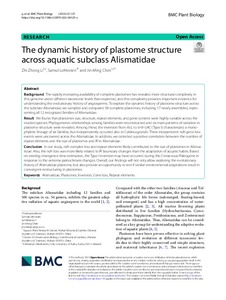The dynamic history of plastome structure across aquatic subclass Alismatidae
Li Zhi Z; Lehtonen Samuli; Chen Jin M
https://urn.fi/URN:NBN:fi-fe2023042538607
Tiivistelmä
Background
The rapidly increasing availability of complete plastomes has revealed more structural complexity in this genome under different taxonomic levels than expected, and this complexity provides important evidence for understanding the evolutionary history of angiosperms. To explore the dynamic history of plastome structure across the subclass Alismatidae, we sampled and compared 38 complete plastomes, including 17 newly assembled, representing all 12 recognized families of Alismatidae.
Result
We found that plastomes size, structure, repeat elements, and gene content were highly variable across the studied species. Phylogenomic relationships among families were reconstructed and six main patterns of variation in plastome structure were revealed. Among these, the inversion from rbcL to trnV-UAC (Type I) characterized a monophyletic lineage of six families, but independently occurred also in Caldesia grandis. Three independent ndh gene loss events were uncovered across the Alismatidae. In addition, we detected a positive correlation between the number of repeat elements and the size of plastomes and IR in Alismatidae.
Conclusion
In our study, ndh complex loss and repeat elements likely contributed to the size of plastomes in Alismatidae. Also, the ndh loss was more likely related to IR boundary changes than the adaptation of aquatic habits. Based on existing divergence time estimation, the Type I inversion may have occurred during the Cretaceous-Paleogene in response to the extreme paleoclimate changes. Overall, our findings will not only allow exploring the evolutionary history of Alismatidae plastome, but also provide an opportunity to test if similar environmental adaptations result in convergent restructuring in plastomes.
Kokoelmat
- Rinnakkaistallenteet [27094]
